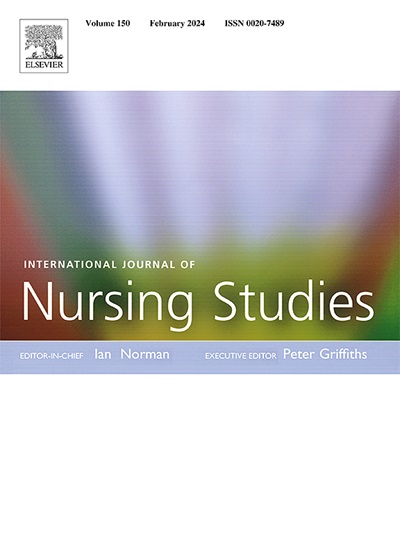Nonpharmacological interventions for childbirth-related post-traumatic stress disorder and accompanying symptoms: A network meta-analysis of randomized controlled trials
IF 7.1
1区 医学
Q1 NURSING
引用次数: 0
Abstract
Background
Childbirth-related post-traumatic stress disorder (CB-PTSD) often coexists with depression and anxiety, but there's a lack of tailored, comparative non-pharmacological treatments.
Objective
This study investigated the efficacy of non-pharmacological interventions in the prevention and alleviation of symptoms associated with CB-PTSD and its accompanying symptoms.
Methods
A comprehensive literature search was conducted across multiple databases, including PubMed, the Cochrane Library, Web of Science, Embase, China National Knowledge Infrastructure, China Science and Technology Journal Database, Wanfang, and China Biology Medicine, up to September 2024. The study included all randomized controlled trials (RCTs) that reported on non-pharmacological interventions for CB-PTSD. Two reviewers independently extracted data, assessed the risk of bias, evaluated the quality of the evidence, and conducted the sub-group analysis and meta-regression. The effectiveness of the intervention strategies was analyzed using a network meta-analysis, with the primary outcome being childbirth-related PTSD and its associated symptoms. The protocol of this study was registered on PROSPERO (ID: CRD42024588020).
Results
This study included a total of 42 RCTs, encompassing 18 distinct intervention types, categorized into three prevention levels: primary prevention during pregnancy (n = 5), aimed at eliminating or mitigating risk factors for CB-PTSD; secondary prevention (n = 26), targeting the reduction of CB-PTSD symptoms following a traumatic birth; and tertiary prevention (n = 11), focusing on the management of women already diagnosed with CB-PTSD.
Comprehensive analysis revealed that in the primary prevention stage, the Birth plan intervention was most effective in reducing CB-PTSD symptom scores compared to conventional postpartum care, while Nurse-led peer support was most effective in reducing depression symptom scores. In the secondary prevention stage, Couples' self-disclosure intervention showed superior efficacy in alleviating CB-PTSD symptoms, and Counseling was most effective for depression and anxiety. At the tertiary prevention stage, Counseling emerged as the most effective intervention for managing CB-PTSD symptoms, whereas Expressive Writing was most effective for depression and anxiety compared to conventional postpartum care.
Conclusions
Non-pharmacological interventions represent a crucial and viable approach for alleviating the symptoms of CB-PTSD. It is imperative to select appropriate and efficacious intervention measures for women during the tertiary prevention phase. Future research can further explore the underlying psychopathology, and relevant clinical guidelines on perinatal mental health may also serve as a valuable reference.
分娩相关创伤后应激障碍及其伴随症状的非药物干预:随机对照试验的网络荟萃分析
分娩相关的创伤后应激障碍(CB-PTSD)通常与抑郁和焦虑并存,但缺乏量身定制的、可比较的非药物治疗方法。目的探讨非药物干预对CB-PTSD及其伴随症状的预防和缓解效果。方法对截至2024年9月的PubMed、Cochrane图书馆、Web of Science、Embase、中国国家知识基础设施、中国科技期刊库、万方、中国生物医学等多个数据库进行综合文献检索。该研究纳入了所有报道CB-PTSD非药物干预的随机对照试验(rct)。两位审稿人独立提取数据,评估偏倚风险,评估证据质量,并进行亚组分析和meta回归。使用网络荟萃分析分析干预策略的有效性,主要结果是分娩相关的创伤后应激障碍及其相关症状。本研究的方案已在PROSPERO (ID: CRD42024588020)上注册。结果本研究共纳入42项随机对照试验,包括18种不同的干预类型,分为三个预防级别:孕期一级预防(n = 5),旨在消除或减轻CB-PTSD的危险因素;二级预防(n = 26),旨在减少创伤性分娩后的CB-PTSD症状;三级预防(n = 11),重点关注已诊断患有CB-PTSD的妇女的管理。综合分析发现,在初级预防阶段,与传统产后护理相比,生育计划干预在降低CB-PTSD症状评分方面最有效,而护士主导的同伴支持在降低抑郁症状评分方面最有效。在二级预防阶段,夫妻自我表露干预对缓解CB-PTSD症状的效果更优,其中心理咨询对抑郁和焦虑的效果最好。在三级预防阶段,咨询是管理产后应激障碍症状最有效的干预措施,而表达性写作与传统的产后护理相比,对抑郁和焦虑最有效。结论非药物干预是缓解CB-PTSD症状的重要且可行的方法。必须在三级预防阶段为妇女选择适当和有效的干预措施。未来的研究可以进一步探讨其潜在的心理病理,相关的围生期心理健康临床指南也可作为有价值的参考。
本文章由计算机程序翻译,如有差异,请以英文原文为准。
求助全文
约1分钟内获得全文
求助全文
来源期刊
CiteScore
15.00
自引率
2.50%
发文量
181
审稿时长
21 days
期刊介绍:
The International Journal of Nursing Studies (IJNS) is a highly respected journal that has been publishing original peer-reviewed articles since 1963. It provides a forum for original research and scholarship about health care delivery, organisation, management, workforce, policy, and research methods relevant to nursing, midwifery, and other health related professions. The journal aims to support evidence informed policy and practice by publishing research, systematic and other scholarly reviews, critical discussion, and commentary of the highest standard. The IJNS is indexed in major databases including PubMed, Medline, Thomson Reuters - Science Citation Index, Scopus, Thomson Reuters - Social Science Citation Index, CINAHL, and the BNI (British Nursing Index).

 求助内容:
求助内容: 应助结果提醒方式:
应助结果提醒方式:


